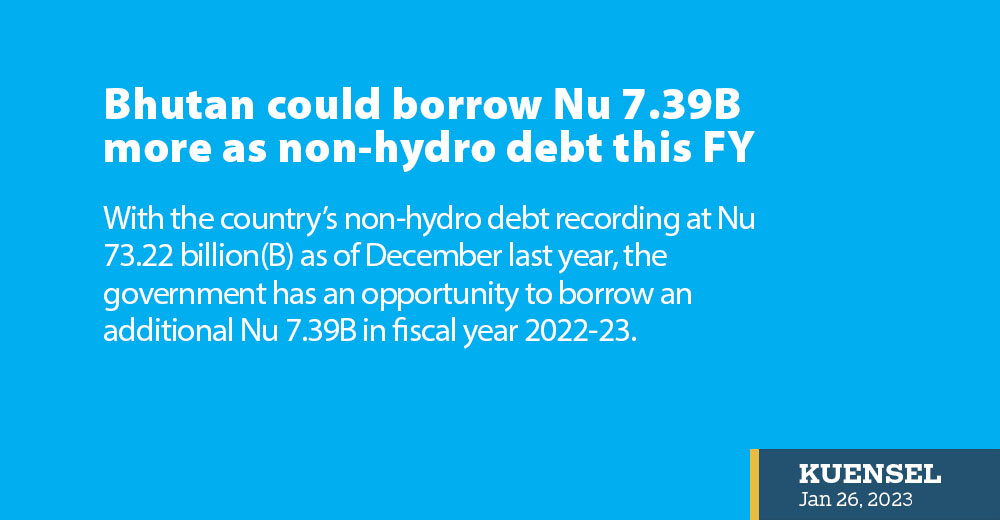Thukten Zangpo
With the country’s non-hydro debt recording at Nu 73.22 billion(B) as of December last year, the government has an opportunity to borrow an additional Nu 7.39B in fiscal year 2022-23.
This is because the Public Debt Policy 2016 prescribes that the non-hydro external debt should not exceed 35 percent of the country’s gross domestic product (GDP) during a five-year plan period.
The figures from the finance ministry show that the average non-hydro debt ratio to GDP for the past four years (including the last quarter of 2022) of the current five-year plan was 31.4 percent, well within the threshold.
This means there is a space of 3.6 percent of the GDP’s estimate for the fiscal year 2022-23 (Nu 205.2B) to borrow, which comes to about Nu 7.39B.
The GDP was estimated based on the second quarter of the fiscal year 2022-23 (November 2022), which could change in the next quarter’s update.
The government can contract debt to finance budget deficits, refinance maturing debt or a loan paid before the redemption date, maintain credit balances in the bank accounts, and for on-lending to state enterprises and other legal entities.
The non-hydro debt at Nu 73.22B constitutes 30.8 percent of the total external debt. It consists of Nu 58.49B government’s budgetary debt, Nu 7.73 commercial debt, and INR 7B central bank’s standby credit facility debt.
Non-hydro debt is contracted from bilateral and multilateral development banks at highly concessional terms, with very low interest rates ranging from zero to 5 percent, and repayment periods as long as 40 years.
Hydropower debt was reported at Nu 164.41B, which was 69.2 percent of the external debt as of December last year.
With Nu 237.63B external debt and Nu 27.2B domestic debt, the total debt stands at Nu 264.83B as of December last year.
The Public Debt Policy 2016 stated that the debt service coverage ratio for a hydropower project has to be above 1.2.
The policy also stated that the ratio of hydropower debt service to hydropower exports revenue was to be maintained at 40 percent in any given year and the debt-equity ratio for hydropower should not exceed 70:30.
With a significant portion of external debt on account of hydropower, the ministry stated that it is deemed commercially viable with a secured export market in India.
The ministry also added that 90.7 percent of the hydro-debt is denominated in INR, which does not pose any exchange rate risks because of the currency pegged.
The external debt threshold, the Public Debt Policy 2016 states that the annual debt service obligations of the total external debt should not exceed 25 percent of the total exports of goods and services.
As per the finance ministry, the external debt servicing for the fiscal year 2021-22 was Nu 9.21B or 15.1 percent of the total external debt service to exports of goods and services, below the threshold.
For fiscal year 2022-23, the ministry projects the external debt service to exports ratio to hit 14.3 percent or Nu 9.34B debt servicing.
With the estimated export bills to reach Nu 65.38B in the fiscal year, the external debt servicing can go up to Nu 16.35B.
The government’s debt service estimated at 21.2 percent or Nu 8.64B for fiscal year 2022-23 was below 22 percent of the domestic revenue, as prescribed by the policy. It includes debt for budgetary activities, hydropower projects, and loans availed by the government and on-lent to public corporations
Breach of threshold
The policy states that any breaches in the debt thresholds will be allowed only during times of economic crisis and other unforeseen exigencies and extraordinary circumstances, where the government has no other means but to raise additional debt in order to maintain socioeconomic stability.
However, the government has to issue a formal directive to the finance ministry to raise additional debt by informing the next sitting of Parliament with a strategy to stabilise debt levels to the standard thresholds prescribed in the policy. The stabilisation period shall not exceed three years.
Meanwhile, the finance ministry is reviewing the Public Debt Policy 2016.


